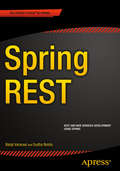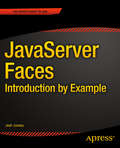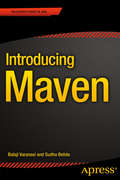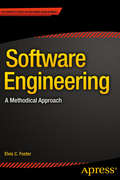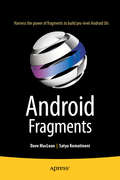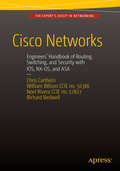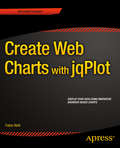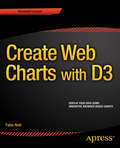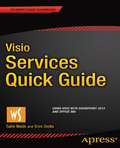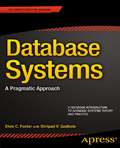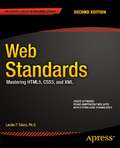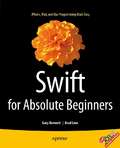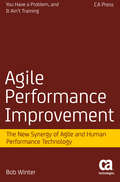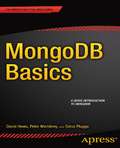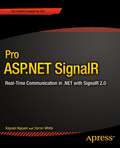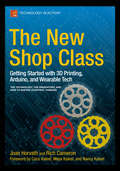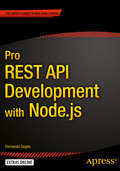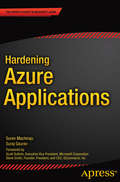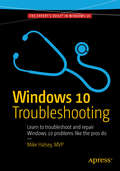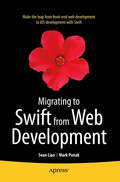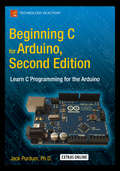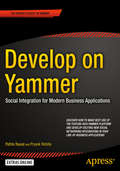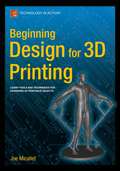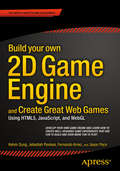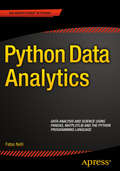- Table View
- List View
Spring REST
by Balaji Varanasi Sudha BelidaSpring REST is a practical guide for designing and developing RESTful APIs using the Spring Framework. This book walks you through the process of designing and building a REST application while taking a deep dive into design principles and best practices for versioning, security, documentation, error handling, paging, and sorting. This book provides a brief introduction to REST, HTTP, and web infrastructure. You will learn about several Spring projects such as Spring Boot, Spring MVC, Spring Data JPA, and Spring Security and the role they play in simplifying REST application development. You will learn how to build clients that consume REST services. Finally, you will learn how to use the Spring MVC test framework to unit test and integration test your REST API. After reading this book, you will come away with all the skills to build sophisticated REST applications using Spring technologies.
JavaServer Faces: Introduction By Example
by Josh JuneauThis book is about using JavaServer Faces to create and deploy interactive applications delivered to end users via a browser interface. JavaServer Faces is the component-based technology enabling easy development of such applications, especially applications of the type commonly needed in enterprise environments. JavaServerFaces: Introduction by Example is a to-the-point, 250-page introduction to an important technology that every Java Enterprise Edition programmer should know and be able to use.JavaServer Faces: Introduction by Example takes you through building and deploying servlet-based web pages built around JavaServer Faces, Facelets, managed Java Beans, and prebuilt user-interface components. You'll learn to build user interfaces that run in the browser, to display data drawn from corporate databases, accept user input, deal with errors and exceptions, and more. JavaServer Faces is an important user-interface technology for any Java developer to learn who works in an enterprise environment. JavaServer Faces: Introduction by Example is your no-nonsense guide to getting started right away in taking advantage of the technology's component-driven approach.Introduces servlets, which are the basis for JavaServer Faces applicationsCovers development and deployment of user interfaces in the browserDemonstrates advanced techniques such as the use of AJAX
Introducing Maven
by Balaji Varanasi Sudha BelidaIntroducing Maven is your quick start-up primer guide on Maven. This fully packed mini-book includes the new features and enhancements found in the latest version of Maven. In this short 100-page book, you'll learn all about Maven and how to set it up to use. You'll learn about the Maven life cycle and how to effectively leverage and use it. Also, you'll learn the basics of using site plugins and generating Javadocs, test coverage/FindBugs reports, version/release notes and more. Furthermore, you'll take advantage of Maven's archetypes to bootstrap new projects easily. Finally, you will learn how to integrate Nexus repository manager with Maven release phases. After reading and using this short book, you'll have an understanding of Maven’s dependency management and how to organize basic and multi-module Maven projects.
Software Engineering: A Methodical Approach
by Elvis FosterThis text provides a comprehensive, but concise introduction to software engineering. It adopts a methodical approach to solving software engineering problems proven over several years of teaching, with outstanding results.The book covers concepts, principles, design, construction, implementation, and management issues of software systems. Each chapter is organized systematically into brief, reader-friendly sections, with itemization of the important points to be remembered. Diagrams and illustrations also sum up the salient points to enhance learning. Additionally, the book includes a number of the author’s original methodologies that add clarity and creativity to the software engineering experience, while making a novel contribution to the discipline.Upholding his aim for brevity, comprehensive coverage, and relevance, Foster’s practical and methodical discussion style gets straight to the salient issues, and avoids unnecessary topics and minimizes theoretical coverage.
Android Fragments
by Dave MacLean Satya KomatineniAndroid Fragments is a 100-page quick start accelerated guide to learning and quickly using Android fragments. You'll learn how to code for fragments; deal with config changes; code for regular vs. fragmented dialogs; work with preferences and saving state; work with the compatibility library; and handle advanced async tasks and progress dialogs.After reading and using this book, which is based on material from the best-selling Pro Android, you'll be an Android UI savant. At the very least, your apps' user interfaces and event handling will be more competitive and better performing, especially for tablet-optimized UIs and events.
Cisco Networks: Engineers' Handbook of Routing, Switching, and Security with IOS, NX-OS, and ASA
by Chris Carthern William Wilson Noel Rivera Richard BedwellThis book is a concise one-stop desk reference and synopsis of basic knowledge and skills for Cisco certification prep. For beginning and experienced network engineers tasked with building LAN, WAN, and data center connections, this book lays out clear directions for installing, configuring, and troubleshooting networks with Cisco devices. The full range of certification topics is covered, including all aspects of IOS, NX-OS, and ASA software. The emphasis throughout is on solving the real-world challenges engineers face in configuring network devices, rather than on exhaustive descriptions of hardware features.This practical desk companion doubles as a comprehensive overview of the basic knowledge and skills needed by CCENT, CCNA, and CCNP exam takers. It distills a comprehensive library of cheat sheets, lab configurations, and advanced commands that the authors assembled as senior network engineers for the benefit of junior engineers they train, mentor on the job, and prepare for Cisco certification exams. Prior familiarity with Cisco routing and switching is desirable but not necessary, as Chris Carthern, Dr. Will Wilson, Noel Rivera, and Richard Bedwell start their book with a review of the basics of configuring routers and switches. All the more advanced chapters have labs and exercises to reinforce the concepts learned. This book differentiates itself from other Cisco books on the market by approaching network security from a hacker’s perspective. Not only does it provide network security recommendations but it teaches you how to use black-hat tools such as oclHashcat, Loki, Burp Suite, Scapy, Metasploit, and Kali to actually test the security concepts learned. Readers of Cisco Networks will learn How to configure Cisco switches, routers, and data center devices in typical corporate network architecturesThe skills and knowledge needed to pass Cisco CCENT, CCNA, and CCNP certification examsHow to set up and configure at-home labs using virtual machines and lab exercises in the book to practice advanced Cisco commandsHow to implement networks of Cisco devices supporting WAN, LAN, and data center configurationsHow to implement secure network configurations and configure the Cisco ASA firewallHow to use black-hat tools and network penetration techniques to test the security of your network
Create Web Charts with jqPlot
by Fabio NelliCreate Web Charts with jqPlotshows how to convert your data into eye-catching, innovative, animated, and highly interactive browser-based charts. This book is suitable for developers of all experience levels and needs: for those who love fast and effective solutions, you can use the jqPlot library to generate charts with amazing effects and animations using only a few lines of code.By the end of the book, you will have a good knowledge of all the elements needed to manage data from every possible source, from high-end scientific instruments to Arduino boards, from simple HTML tables to structured JSON files, and from Matlab calculations to reports in Excel. You will be able to provide cutting-edge charts exploiting the growing power of modern browsers.This book contains content previously published in Beginning JavaScript Charts.Create all kinds of charts using the latest technologies available on browsersFull of step-by-step examples, Create Web Charts with jqPlot introduces you gradually to all aspects of chart development, from the data source to the choice of which solution to apply.This book provides a number of tools that can be the starting point for any project requiring graphical representations of data, whether using commercial libraries or your own
Create Web Charts with D3
by Fabio NelliCreate Web Charts with D3 shows how to convert your data into eye-catching, innovative, animated, and highly interactive browser-based charts. This book is suitable for developers of all experience levels and needs: if you want power and control and need to create data visualization beyond traditional charts, then D3 is the JavaScript library for you.By the end of the book, you will have a good knowledge of all the elements needed to manage data from every possible source, from high-end scientific instruments to Arduino boards, from PHP SQL databases queries to simple HTML tables, and from Matlab calculations to reports in Excel. This book contains content previously published in Beginning JavaScript Charts.Create all kinds of charts using the latest technologies available on browsersFull of step-by-step examples, Create Web Charts with D3 introduces you gradually to all aspects of chart development, from the data source to the choice of which solution to apply.This book provides a number of tools that can be the starting point for any project requiring graphical representations of data, whether using commercial libraries or your own
Visio Services Quick Guide: Using Visio with SharePoint 2013 and Office 365
by Sahil Malik Srini SistlaIn this fast-paced 100-page guide, you’ll learn to load, display and interact with dynamic, data-powered Visio diagrams in SharePoint 2013 or Office 365.Visio Services Quick Guide gives you the tools to build anything from a simple project workflow to an organizational infrastructure diagram, powered by real data from SharePoint or SQL Server. Colleagues can load your diagrams entirely in the browser, meaning that a single Visio client installation is enough to get started. Readers with JavaScript experience will also find out how to get additional control over Visio diagrams using the JavaScript mashup API, and how to build a custom data provider. The final chapter covers some useful information on administering Visio Services.Get started bringing your Visio diagrams to life with the Visio Services Quick Guide.
Database Systems: A Pragmatic Approach
by Elvis Foster Shripad GodboleDatabase Systems: A Pragmatic Approach is a classroom textbook for use by students who are learning about relational databases, and the professors who teach them. It discusses the database as an essential component of a software system, as well as a valuable, mission critical corporate resource. The book is based on lecture notes that have been tested and proven over several years, with outstanding results. It also exemplifies mastery of the technique of combining and balancing theory with practice, to give students their best chance at success. Upholding his aim for brevity, comprehensive coverage, and relevance, author Elvis C. Foster's practical and methodical discussion style gets straight to the salient issues, and avoids unnecessary fluff as well as an overkill of theoretical calculations. The book discusses concepts, principles, design, implementation, and management issues of databases. Each chapter is organized systematically into brief, reader-friendly sections, with itemization of the important points to be remembered. It adopts a methodical and pragmatic approach to solving database systems problems. Diagrams and illustrations also sum up the salient points to enhance learning. Additionally, the book includes a number of Foster's original methodologies that add clarity and creativity to the database modeling and design experience while making a novel contribution to the discipline. Everything combines to make Database Systems: A Pragmatic Approach an excellent textbook for students, and an excellent resource on theory for the practitioner.
Web Standards: Mastering HTML5, CSS3, and XML
by Leslie SikosWeb Standards: Mastering HTML5, CSS3, and XML provides solutions to the most common web design problems, and gives you a deep understanding of web standards and how they can be implemented to improve your web sites. You will learn how to develop fully standards-compliant, mobile-friendly, and search engine-optimized web sites that are robust, fast, and easy to update while providing excellent user experience and interoperability. The book covers all major web standards for markup, style sheets, web typography, web syndication, semantic annotations, and accessibility. This edition has been fully updated with the latest in web standards, including the finalized HTML5 vocabulary and the full list of CSS3 properties. Web Standards: Mastering HTML5, CSS3, and XML is also a comprehensive guide to current and future standards for the World Wide Web, demonstrating the implementation of new technologies to address the constantly growing user expectations. Web Standards: Mastering HTML5, CSS3, and XML presents step-by-step guides based on solid design principles and best practices, and shows the most common web development tools and web design frameworks. You will master HTML5 and its XML serialization, XHTML5, the new structuring and multimedia elements, the most important HTML5 APIs, and understand the standardization process of HTML 5.1, HTML 5.2, and future HTML5 versions.
Swift for Absolute Beginners: Learn To Develop Apps For Ios
by Gary Bennett Brad LeesThe professional development team that brought you two editions of Objective-C for the Absolute Beginners and have taught thousands of developers around the world to write some of the most popular iPhone apps in their categories on the app store, have now leveraged their instruction for Swift.Swift for Absolute Beginners is perfect for those with no programming background, those with some programming experience but no object-oriented experience, or those that have a great idea for an app but haven’t programmed since school.Gary Bennett and Brad Lees are full-time professional iOS developers and have developed a broad spectrum of apps for Fortune 500 companies. The authors have taken their combined 12 years of writing apps, teaching online iOS courses, the experience from their first two iOS books, along with their free online instruction and free online forum to create an excellent training book.Topics include:How to be successful at learning SwiftUsing Swift Playgrounds to learn iOS development quicklyWhat is Object Oriented ProgrammingWhat are Swift classes, properties, and functionsProper user interface and user experience designSwift data types: integers, floats, strings, booleansHow to use Swift data collections: arrays and dictionariesBoolean logic, comparing data, and flow controlWriting iPhone apps from scratchAvoiding Swift pitfallsMany students have a difficult time believing they can learn to write iOS apps or just staying motivated through learning the process. This book, along with the free, live online training sessions, helps students stay motivated and overcome obstacles while they learn to be great iOS developers.
Agile Performance Improvement: The New Synergy of Agile and Human Performance Technology
by Robert Winter"1+1=3. That is the equation that summarizes the theme of this book. The book’s message is to integrate the developmental principles of Agile with the result-focused approaches integral to performance consulting. Your outcomes in shaping human performance will be significant--and greater than if you only used one of these models. This is a book for anyone who seeks to work collaboratively with leaders to bring about continuously improving and sustainable organizational change." --Dana Gaines Robinson, coauthor of Performance ConsultingAgile Performance Improvement demonstrates the mutual benefits that accrue to the worlds of performance consulting and agile software development when the values and principles of both are blended synergistically under the guidance of practitioners skilled in both. The agile performance improvement model blends the principles of human performance technology with the frameworks and practices of Agile. The result is an approach that maximizes the value of interactions among the consultant, the work team, and the customer. Unlike traditional end-to-end waterfall processes, agile performance improvement delivers value continuously and in small increments, relentlessly focusing on outcomes of value to the customer. Building on structures of Agile that are used in software development, such as Scrum, the agile performance improvement model considers the human component of holistic solutions in establishing a continuous stream of value.Bob Winter, a performance consultant, was the product owner for the corporate education scrum supporting an agile transition initiative for hundreds of engineering teams. From this cross-disciplinary experience, he discovered that the two cultures, two languages, and two methodologies of performance consulting and agile software development are—far from being incongruent, incompatible, or irrelevant to each other—in fact ideally suited to complement and support each other. Being agile improves the effectiveness of the performance consultant, and applying the lessons of human performance technology improves the effectiveness of software development teams.In Agile Performance Improvement, Winter teaches performance consultants how to apply agile principles, values, and methods usefully to the tasks of optimizing human performance in areas of practice not only adjoining but also well beyond the realm of software and IT engineering, such as corporate learning solutions, human resources systems, and non-software products. Conversely, he shows engineering teams immersed in an agile environment how to boost their performance using the principles and techniques taught and cultivated by performance consultants. The author, who has worked extensively on both sides of the traditional divide, recounts entertainingly but informatively how both sparks and fur can fly when geeks encounter people people.
MongoDB Basics
by Peter Membrey David Hows Eelco PluggeNeed a quick and easy to understand introduction to MongoDB and NoSQL databases? MongoDB Basics, from The Definitive Guide to MongoDB, 2E, shows you how a document-oriented database system differs from a relational database, and how to install and get started using it. You'll also learn MongoDB design basics, including geospatial indexing, how to navigate, view, and query your database, and how to use GridFS with a bit of Python.
Experimenting with AVR Microcontrollers
by Alan TrevennorAVR is the brain that runs Arduino, but you don't need the whole Arduino board to do fun projects. Experimenting with AVR Microcontrollers, from Practical AVR Microcontrollers, shows you how to create a spiffy set of projects that you can build to learn more about electronics, about AVR, and just to generate new ideas for your own projects. Alan Trevennor will show you how to create a secret panel project, a gadget to drive your pets crazy, a hallway lighting system, and even a small home automation network.
The New Shop Class: Getting Started with 3D Printing, Arduino, and Wearable Tech
by Joan Horvath Richard Cameron Doug AdriansonThe New Shop Class connects the worlds of the maker and hacker with that of the scientist and engineer. If you are a parent or educator or a budding maker yourself, and you feel overwhelmed with all of the possible technologies, this book will get you started with clear discussions of what open source technologies like 3D printers, Arduinos, robots and wearable tech can really do in the right hands. Written by real "rocket scientist" Joan Horvath, author of Mastering 3D Printing, and 3D printing expert Rich Cameron (AKA whosawhatsis), The New Shop Class is a friendly, down-to-earth chat about how hands-on making things can lead to a science career.Get practical suggestions about how to use technologies like 3D printing, Arduino, and simple electronicsLearn how to stay a step ahead of the young makers in your life and how to encourage them in maker activitiesDiscover how engineers and scientists got their start, and how their mindsets mirror that of the maker
Pro REST API Development with Node.js
by Fernando DoglioPro REST API Development with Node.js is your guide to managing and understanding the full capabilities of successful REST development. API design is a hot topic in the programming world, but not many resources exist for developers to really understand how you can leverage the advantages.This book will provide a brief background on REST and the tools it provides (well known and not so well known). Understand how there is more to REST than just JSON and URLs. You will then cover and compare the maintained modules currently available in the npm community, including Express, Restify, Vatican, and Swagger. Finally you will code an example API from start to finish, using a subset of the tools covered.The Node community is currently flooded with modules; some of them are published once and never updated again - cluttering the entire universe of packages. Pro REST API Development with Node.js shines light into that black hole of modules for the developers trying to create an API. Understand REST API development with Node.js using this book today.
Hardening Azure Applications: Techniques And Principles For Building Large-scale, Mission-critical Applications
by Suraj Gaurav Suren MachirajuLearn what it takes to build large scale, mission critical applications -hardened applications- on the Azure cloud platform.This 208 page book covers the techniques and engineering principles that every architect and developer needs to know to harden their Azure/.NET applications to ensure maximum reliability and high availability when deployed at scale. While the techniques are implemented in .NET and optimized for Azure, the principles here will also be valuable for users of other cloud-based development platforms.Applications come in a variety of forms, from simple apps that can be built and deployed in hours to mega-scale apps that need significantly higher engineering rigor and robust organizations to deliver them. How do you build such massively scalable applications to keep pace with traffic demands while always being ‘online’ with five 9's availability?The authors take you step by step through the process of evaluating and building applications with the appropriate hardness attributes. For example, it is easy to say that an application should be available "all the time", but it is very important to understand what each level of 9 for availability means and the resulting implications on engineering and resources. The book explains the details required for developers and IT Pros to get it right in Azure.
Windows 10 Troubleshooting
by Mike HalseyLearn how to troubleshoot Windows 10 the way the experts do, whatever device or form-factor you’re using. Focus on the problems that most commonly plague PC users and fix each one with a step-by-step approach that helps you understand the cause, the solution, and the tools required. Discover the connections between the different hardware and software in your devices, and how their bonds with external hardware, networks, and the Internet are more dependent than you think, and learn how to build resilience into any computer system, network, or device running Windows 10.If you're fed up of those nagging day-to-day issues, want to avoid costly repairs, or just want to learn more about how PCs work, Windows 10 Troubleshooting is your ideal one-stop guide to the Windows 10 operating system.What You Will Learn:Understand your PC’s ecosystem and how to connect the dots, so you can successfully track problems to their sourceCreate resilient backups of your operating system, files, and documents, and enable quick and easy restoreLearn your way around Windows' built-in administration tools, to quickly fix the typical problems that come upDiagnose and repair a wide range of common problems with printers and other essential peripheralsSolve complex startup problems that can prevent a PC form bootingMake your PC safe and secure for the whole family, and for everybody in your workplaceUnderstand the threat from malware and viruses and a range of approaches to dealing with them, depending on the situationBomb-proof your PC with advanced security, group policy, and firewall policiesLearn the top Tips and tricks for researching difficult problems, including third-party tools and useful web resourcesWork with the registry, file system, and Sysinternals to troubleshooting PCs in the workplaceWho This Book Is For:Anyone using Windows 10 on a desktop, laptop, or hybrid device
Migrating to Swift from Web Development
by Sean Liao Mark Punak Anthony NemecMigrating to Swift From Web Development gives you the ability to create native iOS apps using the latest Swift programming language. Starting with preparing your latest Xcode 6 Integrated Development Environment and introducing just enough iOS application framework fundamentals, you'll understand how to create a simple but meaningful Hello Swift application for iOS 8 immediately.After the short IDE setup guide, this book will show you how to structure your iOS project from an existing mobile web app. Every topic comes with a tutorial project that you will create by yourself. You'll plan and structure your iOS apps using Xcode Storyboard, implementing use cases with detailed screens, and learn about managing data and working with remote services. Finally, you’ll experience a recap of the whole porting process by translating a mobile web app to iOS 8 from start to end. When you finish reading Migrating to Swift from Web Development, you'll be an iOS developer as well as a front-end web developer.
Beginning C for Arduino, Second Edition: Learn C Programming for the Arduino
by Jack PurdumBeginning C for Arduino, Second Edition is written for those who have no prior experience with microcontrollers or programming but would like to experiment and learn both. Updated with new projects and new boards, this book introduces you to the C programming language, reinforcing each programming structure with a simple demonstration of how you can use C to control the Arduino family of microcontrollers. Author Jack Purdum uses an engaging style to teach good programming techniques using examples that have been honed during his 25 years of university teaching. Beginning C for Arduino, Second Edition will teach you:The C programming language How to use C to control a microcontroller and related hardware How to extend C by creating your own libraries, including an introduction to object-oriented programmingDuring the course of the book, you will learn the basics of programming, such as working with data types, making decisions, and writing control loops. You'll then progress onto some of the trickier aspects of C programming, such as using pointers effectively, working with the C preprocessor, and tackling file I/O. Each chapter ends with a series of exercises and review questions to test your knowledge and reinforce what you have learned.
Develop on Yammer: Social Integration for Modern Business Applications
by Pathik Rawal Pryank RohillaDevelop on Yammer is your guide to integrating the Yammer social network with your company’s application ecosystem. By developing custom apps and features on the Yammer platform, you can make your workplace more productive, encourage communication and feedback, and get your colleagues collaborating across a range of platforms, including SharePoint, ASP.NET, and Windows Phone.The book begins with an introduction to the development options available along with guidance on how to set up a Yammer developer account. You’ll then take your first step in Yammer integration by building a Yammer feed into a web page or other JavaScript-based client application, before diving into app creation and management on the Yammer platform. The authors provide a deep dive into the Yammer authorization process from client-side and server-side perspectives, and you’ll find out how to work closely with Yammer’s data streams and its full range of development possibilities using Open Graph and Yammer’s REST API. The final chapters cover how to build Yammer integration into standalone applications for SharePoint and Windows Phone 8 with Yammer SDKs.All chapters are illustrated with examples and sample code, and a case study follows the development of a workplace training application as the authors apply each technique, so you can see how to make the most of what Yammer has to offer.What You'll LearnWhy develop on Yammer, and what development options are available How to add a Yammer feed to an HTML-based application using Yammer Embed, to bring relevant news and discussions into the contexts where they matterHow to develop custom Yammer features for your SharePoint, Office or web applications on the client side with the Yammer JavaScript SDKHow to carry out secure authorization and authentication on YammerHow to use Yammer Open Graph and REST APIs to posts messages, create custom activities and get data from Yammer-integrated applicationsHow to work with the Yammer Windows Phone 8 SDK to add Yammer functionality to a Windows Phone 8 applicationWho This Book Is ForThis book is targeted at developers with a background in .NET/C# development. Readers should be comfortable working with JavaScript.Software architects will also find this book valuable for planning social integration across their companies' business ecosystems.
Beginning Design for 3D Printing
by Joe MicallefBeginning Design for 3D Printing is the full color go-to-guide for creating just about anything on a 3D printer. This book will demystify the design process for 3D printing, providing the proper workflows for those new to 3D printing, eager artists, seasoned engineers, 3D printing entrepreneurs, and first-time owners of 3D printers to ensure original ideas can be 3D printed. Beginning Design for 3D Printing explores a variety of 3D printing projects. Focus is on the use of freely available 3D design applications with step-by-step techniques that will demonstrate how to create a wide variety of 3D printable objects and illustrate the differences between splines, polygons, and solids. Users will get a deep understanding of a wide range modeling applications. They'll learn the differences between organic modeling tools, hard edge modeling, and precision, CAD-based techniques used to make 3D printable designs, practical products, and personalized works of art. Whether you are a student on a budget or a company exploring R & D options for 3D printing, Beginning Design for 3D Printing will provide the right tools and techniques to ensure 3D printing success.
Build your own 2D Game Engine and Create Great Web Games: Using HTML5, JavaScript, and WebGL
by Kelvin Sung Jebediah Pavleas Fernando Arnez Jason PaceBuild Your Own 2D Game Engine and Create Great Web Games teaches you how to develop your own web-based game engine step-by-step, allowing you to create a wide variety of online videogames that can be played in common web browsers. Chapters include examples and projects that gradually increase in complexity while introducing a ground-up design framework, providing you with the foundational concepts needed to build fun and engaging 2D games. By the end of this book you will have created a complete prototype level for a side scrolling action platform game and will be prepared to begin designing additional levels and games of your own.This book isolates and presents relevant knowledge from software engineering, computer graphics, mathematics, physics, game development, game mechanics, and level design in the context of building a 2D game engine from scratch. The book then derives and analyzes the source code needed to implement these concepts based on HTML5, JavaScript, and WebGL. After completing the projects you will understand the core-concepts and implementation details of a typical 2D game engine and you will be familiar with a design and prototyping methodology you can use to create game levels and mechanics that are fun and engaging for players. You will gain insights into the many ways software design and creative design must work together to deliver the best game experiences, and you will have access to a versatile 2D game engine that you can expand upon or utilize directly to build your own 2D games that can be played online from anywhere.• Assists the reader in understanding the core-concepts behind a 2D game engine• Guides the reader in building a functional game engine based on these concepts• Leads the reader in exploring the interplay between technical design and game experience design• Teaches the reader how to build their own 2D games that can be played across internet via popular browsers
Python Data Analytics: Data Analysis and Science using pandas, matplotlib and the Python Programming Language
by Fabio NelliPython Data Analytics will help you tackle the world of data acquisition and analysis using the power of the Python language. At the heart of this book lies the coverage of pandas, an open source, BSD-licensed library providing high-performance, easy-to-use data structures and data analysis tools for the Python programming language.Author Fabio Nelli expertly shows the strength of the Python programming language when applied to processing, managing and retrieving information. Inside, you will see how intuitive and flexible it is to discover and communicate meaningful patterns of data using Python scripts, reporting systems, and data export. This book examines how to go about obtaining, processing, storing, managing and analyzing data using the Python programming language.You will use Python and other open source tools to wrangle data and tease out interesting and important trends in that data that will allow you to predict future patterns. Whether you are dealing with sales data, investment data (stocks, bonds, etc.), medical data, web page usage, or any other type of data set, Python can be used to interpret, analyze, and glean information from a pile of numbers and statistics. This book is an invaluable reference with its examples of storing and accessing data in a database; it walks you through the process of report generation; it provides three real world case studies or examples that you can take with you for your everyday analysis needs.
